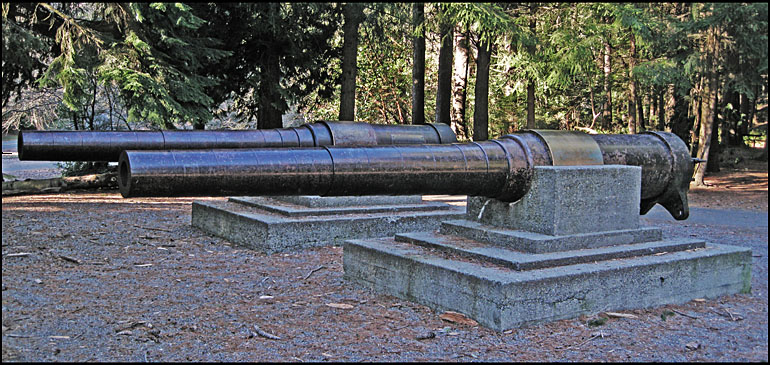
Naval Guns from USS Boston
Hamlin Park, Shoreline, Washington

In the 1970s, I used to walk on my way home from school past these relics from the protected cruiser
USS Boston, 1887–1946, and I wondered then how they ever ended up in Hamlin Park. These
8-inch 30-caliber guns were mounted fore and aft on the USS Boston, which was commissioned on
May 2, 1887, and measured 283 feet in length. The USS Boston was a steam brig and had the very
remarkable distinction of being one of the first four U.S. Navy vessels built with a steel hull, rather than an iron
hull. These first four so-called “ABCD ships” included the USS Atlanta, USS
Boston, USS Chicago, and USS Dolphin. These four vessels were
constructed in accordance with the Naval Appropriations Acts of August 5, 1882, and March 3, 1883. Their
steel hull construction provided great tensile strength and ductility and marked the beginning of the
transition to an upgraded, modernized, “New Steel Navy.” An article about the 8-inch 30-caliber
guns appeared in the February 28, 1945, issue of The Stethoscope, published by the U.S. Naval
Hospital, at Seattle, Washington. As it turns out, this pair of 8-inch 30-caliber guns were once displayed,
facing south, on the east and west side of the administrative building of the U.S. Naval Hospital, at
Seattle. The two-story, wood-frame, administrative building of the U.S. Naval Hospital was located about a
half-mile south of where the 8-inch 30-caliber guns are now located in Hamlin Park. The 8-inch 30-caliber
guns were originally placed at the U.S. Naval Hospital because of their very remarkable commemorative
significance to United States naval history. They were moved to Hamlin Park, many years ago, most likely as
a memorial in remembrance of the neighboring site of the WWII era U.S. Naval Hospital.

The U.S. Naval Hospital, at Seattle, was commissioned on August 22, 1942, and it was one of the hospitals
where many of the wounded, in World War II, were brought. The U.S. Naval Hospital, at Seattle, was actually
located just a few blocks outside of the Seattle city limits, in what is now the City of Shoreline. The
main part of the hospital facility eventually had over 60 buildings and was spread out over about 90 acres,
of an approximately 160-acre property. Captain Franklin F. Murdoch became the initial commanding officer of
the hospital. Captain Murdoch secured, from the Bremerton Navy Yard, the pair of 8-inch 30-caliber guns,
which were then placed on opposite sides of the hospital administration building, soon after the
commissioning of the hospital. Captain Joel T. Boone was the next commanding officer of the hospital, from
May 18, 1943, to March 11, 1945, followed by Captain Franklyn C. Hill, who then became the commanding
officer there until 1947. When the hospital closed, in 1947, the facility was transfered from the
Department of the Navy to King County, at a navy flag lowering ceremony, on November 3, 1947. A map,
titled U.S. Naval Hospital, Seattle, Wash., Showing Conditions on June 30, 1944, reveals that the
U.S. Naval Hospital administrative building, where the 8-inch 30-caliber guns were placed, was located
only about a couple hundred feet northeast of the road intersection of NE 150th Street and 17th Ave. NE.
The 1944 map shows that the main hospital entrance and sentry gatehouse were located on the north side of
that road intersection. The map also shows that the hospital's commanding officer's house, as well
as two other officers' houses, a building for bachelor officer quarters, and a tennis court were all
located in what is now South Woods Park. The officer's tennis court pavement still remains, hidden in
the woods, mostly concealed by an organic layer and forest undergrowth.

Captain Joel T. Boone, commanding officer of the U.S. Naval Hospital, at Seattle, performed the ceremonial
ground-breaking for the hospital chapel, on May 28, 1944. The chapel was started at the suggestion of
Captain Joel T. Boone and he selected the very location of the building site, which was intentionally
situated on a secluded knoll amongst tall firs. When construction of the navy's Chapel on the
Hill was completed, Captain Joel T. Boone also delivered the dedicatory address, on November 12, 1944.
Joel T. Boone was a World War I recipient of the Medal of Honor, for extraordinary heroism, while serving
in the Marines. He also, as a lieutenant commander, had been the medical officer on board the 273-foot
presidential yacht, USS Mayflower, from 1922 to 1929, and had been the White House physician, from
1929 to 1933. The 453-foot frigate USS Boone (FFG 28) was named in his honor. The Chapel on the
Hill is historically significant, since it was the first chapel at any naval hospital in the United
States. Although most of the buildings from the U.S. Naval Hospital, at Seattle, are long gone the little
brick Chapel on the Hill remains, secluded timelessly on the wooded knoll, snug in amongst the
tall firs as Captain Joel T. Boone had originally envisioned.
<< BACK
 Andrew Craig Magnuson
Andrew Craig Magnuson
Forks, Washington
January 25, 2017

Copyright © by Andrew Craig Magnuson

|